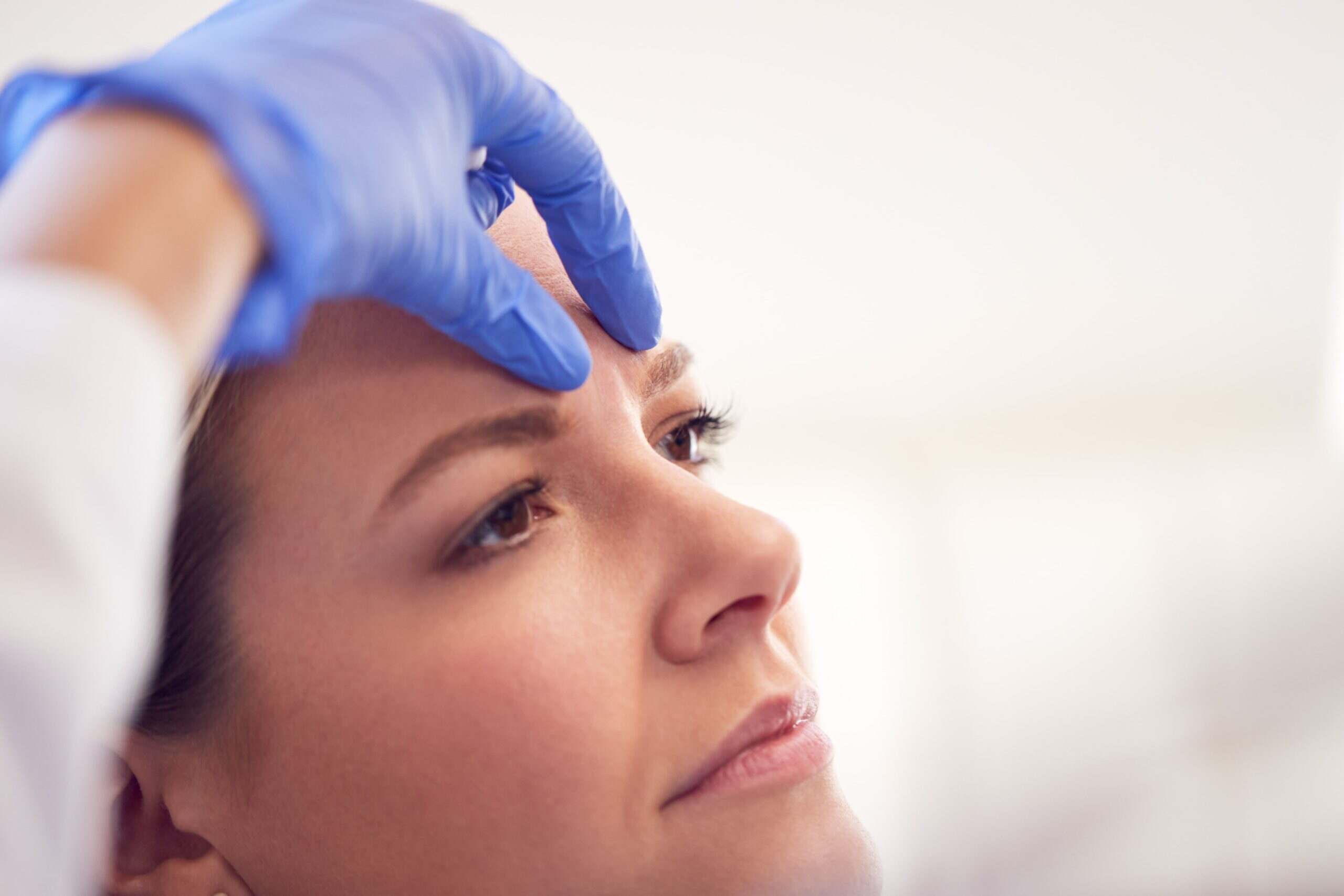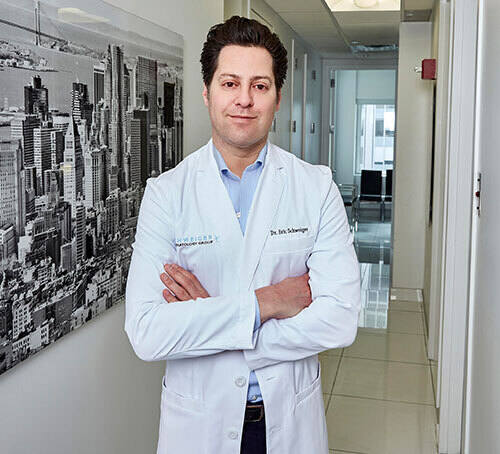Dermal Fillers and Injectables

The correction of deep facial wrinkles, particularly in areas resistant to other techniques (e.g., Botox, etc.), has been revolutionized by the development of reliable injectable dermal fillers.
Facial Wrinkles
Facial wrinkles are a sign of aging but are also a function of several other factors, including:
- Strong facial musculature may produce deep furrows.
- Sun exposure and cigarette smoke can produce fine wrinkles.
- Genetic factors make each individual more or less likely to develop wrinkles at any given age.
- Loss of facial volume contributes to facial wrinkles.
Facial Areas Commonly Treated With Dermal Fillers
Dermal fillers treat static wrinkles–those caused by a combination of gravity and loss of skin elasticity–they are typically located in the lower 2/3s of the face. These types of wrinkles include the nasolabial folds (those that go from the nose to the corner of the lips), marionette lines (those that go from the corner of the lips to the chin), “smoker’s lines” around the mouth, and fat loss in the cheeks.
Our clinicians use reversible dermal fillers, such as Restylane and Juvederm (hyaluronic acid-based fillers) to:
- Correct the depressions found along the junction between the eyes and cheeks, known as the tear trough
- Correct the crease between the nose and the lips, known as the nasolabial folds
- Improve the marionette lines below the lips
- Fill thin lips
- Correct temple hollows
- Aid in scar camouflage
- Improve other areas depending on the patient’s needs/anatomy
Types of Fillers Used on the Face
There are numerous dermal filler products available today that are used on the face. Whether you want to fill in those smile lines or add volume to your cheek area, our dermatology providers will pinpoint which product best suits your needs during your consultation. From Juvederm to Perlane to Radiesse and Sculptra, the various options allow us to tailor the filler to your individual circumstances.
Hyaluronic Acid-Based Fillers
Hyaluronic acid-based fillers are currently the most popular injectable filler products used in the United States today. Hyaluronic acid (HA) is a naturally occurring material in all vertebrate animals and can be produced by some bacteria. This non-cellular material does not produce an allergic reaction. Therefore, it requires no skin test. It fits the need for a longer-acting material that is potentially reversible, has a favorable risk profile, and provides natural-appearing results. Generally, hyaluronic acid products offer 9-24+ months of effect and the possibility of more prolonged effects with repeat injections. Some products contain lidocaine, an anesthetic that may improve the experience of receiving the injections.
Examples of hyaluronic acid-based fillers include Restylane™, Juvederm™, Volbella®, Vollure®, Voluma®, Ultra®, Ultra plus®, and RHA®.
RHA® Collection
The new RHA® collection of fillers represents the latest advancement in hyaluronic acid (HA) technology in more than a decade. It is the only FDA-approved hyaluronic acid filler for dynamic wrinkles and folds. It uses a gentle manufacturing process that helps to preserve the natural structure of the HA, allowing it to mimic the natural HA found in your skin. Results from the RHA® Collection are immediate, delivering natural-looking results for dynamic areas of the face for long-lasting results for up to 15 months.
Other Products
Multiple other materials have been developed with variability regarding the duration of effect, risk of complication, and overall natural-appearing results, such as:
- Radiesse™ is a hydroxyapatite product that is also popular and produces results in 12-18 months. It may be used for deep nasolabial and marionette folds and cheek augmentation.
The risk of bumps or irregularities is possible with all injectable fillers, but many physicians feel they are less likely to happen with hyaluronic acid fillers than others.
Dermal Fillers and Injectables Near You in NY, NJ, PA, CT, FL, IL, MN and MO
Call Schweiger Dermatology Group today at (844) DERM-DOC to schedule your consultation for dermal fillers and injectables. Our clinicians are skilled and experienced in helping patients achieve a natural look with injectable treatments for facial rejuvenation.
Dermal Fillers and Injectables FAQs
-
Are dermal fillers and injectables the same as Botox?
Dermal fillers and injectables are very different from Botox, though they can be used nicely together to improve the appearance of your skin. While Botox is a protein that relaxes the overactive muscles of the face (to decrease wrinkle formation), dermal fillers and injectables add volume. Dermal fillers and injectables do not affect the facial muscles; instead, they fill in areas of volume loss or deep wrinkles. While the effects of Botox last up to 4 months, dermal fillers and injectables last between 6 months and 2 years. Botox and dermal fillers and injectables are often used together to smooth out the dynamic muscles of the face due to overactivity and to improve areas of volume loss over time.
-
How long does it take to see results from dermal fillers?
Results are immediate with dermal fillers but may take up to 2 weeks to settle to the final result.
-
Is it a good idea to schedule dermal fillers and injectables before an important event?
We would advise that you not schedule dermal filler and injectable procedures within a week before an important event (such as a wedding) because there is always a chance of bruising. Plus, on rare occasions, swelling may last a day or two. Lip filler may result in swelling lasting 5-7 days.
-
What is the recovery time after filler and injectable procedures?
Most patients can return to regular activity or work an hour after application. Note, though, that swelling may take several hours to resolve, so you should refrain from exercising or from any strenuous activity that day.
-
How are dermal fillers administered?
Before dermal fillers are administered, a topical anesthetic cream is applied to your face. While your clinician is injecting the fillers with a very fine cannula, an assistant will apply acupressure to various points on your face to help decrease the sensation of the filler as it is being applied. After application, an ice pack is placed on the injection site for 20 minutes to reduce local swelling.
-
How do you prepare for injectable filler treatment?
For 5 days before the procedure, you should avoid aspirin or anti-inflammatory medications to limit bruising after the procedure unless prescribed for you by your doctor.
-
What type of dermal filler do you use for lip augmentation?
Our clinicians use hyaluronic acid-based fillers to enhance the appearance of lips that might otherwise seem too thin. Most lip fillers contain the numbing medication lidocaine and the filler itself, thereby creating a painless process.
Treatment takes about 30 minutes. A tiny injection is placed into the targeted area, and ice is applied to the injection site before you leave the office to help with any swelling and bruising that might occur.
Before you leave, we schedule a follow-up appointment to check on progress and determine if more filler is needed to achieve your desired look.
-
What is Juvederm?
Juvederm is a dermal filler made of hyaluronic acid. It is used to fill in areas of volume loss or deep folds (such as smile lines) that have become more apparent over time. Treatment with Juvederm is relatively painless, as the newer formulation (called Juvederm XC) contains a numbing agent. The most common areas to be treated with Juvederm include the smile lines, under-eye circles, lips, and cheeks. A single treatment lasts from 6-9 months. Juvederm filler is an excellent treatment for men or women who desire a more youthful and rejuvenated appearance without the need for surgery.
-
How is Sculptra different from other dermal fillers?
Sculptra is a poly-L-lactic acid dermal filler that is placed below the skin to add volume and fill in deep folds of the face. It is unique because it not only fills in the nasolabial folds (smile lines) but also stimulates your body’s collagen production. This process results in longer-lasting and more dramatic improvement of volume depletion that comes with aging.
Sculptra treatment is usually performed over a series of three visits.
Unlike other dermal fillers, the results of Sculptra are not instantly appreciated. After the short series of treatments, the effect is dramatic, and the results last for up to 5 years!
Sculptra treatment is recommended for the areas of the face that can benefit the most from volumizing, such as the nasolabial folds (smile lines), hollowing of the midface, the cheeks, and the temples. The effects of Sculptra are dramatic but natural-looking. Some people even refer to it as injectable plastic surgery due to its long-lasting results.
-
Does Xeomin® treat facial wrinkles?
Xeomin® is one of the best ways to treat facial wrinkles that develop due to overactive face muscles. It softens muscle activity in the treated area, which allows for treatment and prevention of facial wrinkles. Xeomin® works exceptionally well for treating the forehead, crow’s feet, and wrinkles between the eyebrows.
-
Is Xeomin® the Same as Botox®?
Xeomin® and Botox® are similar compounds, which are commonly used to treat the same areas of the face. Both treatments are used to block excessive muscle activity to improve the appearance of facial wrinkles. The difference is that Xeomin® (incobotulinumtoxin A) and Botox® (onobotulinumtoxin A) are slightly different molecules, though they work similarly. Xeomin® is different from Botox® in that it does not contain additives, only active ingredients. As a result, the risk of developing antibodies (which could stop treatment from working as well) is lessened with Xeomin® when compared to other similar treatments.
-
Which dermal fillers are recommended for under the eye?
Our dermatology providers recommend Juvederm and Restylane for dark circles, under-eye bags, hallowing, and a chronically tired look. These fillers are a great, non-surgical option to improve the appearance of the under-eye area.
The effects of treatment typically last for 6 to 9 months.
